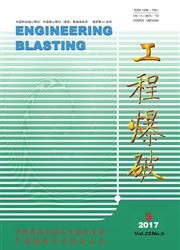

 中文摘要:
中文摘要:
运用HHT分析方法对深圳地铁7号线及北京地铁16号线的实测爆破振动信号进行分析,对比普通毫秒延时雷管和电子雷管在爆破振动强度、延时时间、时频特性和能量分布特征等方面的不同。结果表明:电子雷管应用于单孔连续起爆技术,能量利用率高,可以有效的减小爆破振动强度和振动持续时间,在降低了单段装药量的同时增加了循环进尺深度。普通毫秒雷管爆破产生的瞬时能量较大,在频带范围内的分布相对较广;电子雷管的瞬时能量相对较小,且在频带上分布多集中在中低频部分。利用HHT瞬时能量法可以有效识别普通毫秒雷管的实际延时时间,而电子雷管相邻段位间的延时间隔时间很小,爆炸应力波发生了复杂的叠加和干扰,识别出的突变峰值明显小于普通毫秒雷管的爆破。
 英文摘要:
英文摘要:
Based on the HHT method,the difference between common millisecond detonators and digital detonators in explosion vibration signal such as the blasting vibration intensity,delay time,time-frequency characteristics and energy distribution characteristics were analyzed and compared based on actual explosion experiments in Shenzhen metro line 7and Beijing metro line 16.The result indicated electronic detonator used in continuous blasting of single hole with high energy utilization ratio,blasting vibration intensity and vibration duration could be effectively reduced,the advance per round was increased and the charge of single hole was reduced.The common millisecond detonators produced instantaneous energy and distributed in frequency band range more widely than digital detonators.The HHT instantaneous energy method was effectively to identify the common millisecond detonator real delay time.The electronic detonator adjacent delay interval time was very short,and explosive stress wave identified the peak mutation significantly less than blasting of common millisecond detonators because of complex superposition and interference.
 同期刊论文项目
同期刊论文项目
 同项目期刊论文
同项目期刊论文
 Application on intelligent system for optimization design of blasting in mine tunnel excavation of c
Application on intelligent system for optimization design of blasting in mine tunnel excavation of c High-strength steel tubular confined concrete supports support technology for large section soft roc
High-strength steel tubular confined concrete supports support technology for large section soft roc Method for pinpointing the contacts of oil, gas and water by common contour binning stacking and its
Method for pinpointing the contacts of oil, gas and water by common contour binning stacking and its Experimental study on the effect of initial compression stress field on blast-induced crack behavior
Experimental study on the effect of initial compression stress field on blast-induced crack behavior Experimental study of dynamic fracture effect of blasting crack in slotted cartridge decoupling char
Experimental study of dynamic fracture effect of blasting crack in slotted cartridge decoupling char SEM experiment of rock crack cross section morphology after explosion fracturing with slotted cartri
SEM experiment of rock crack cross section morphology after explosion fracturing with slotted cartri 期刊信息
期刊信息
